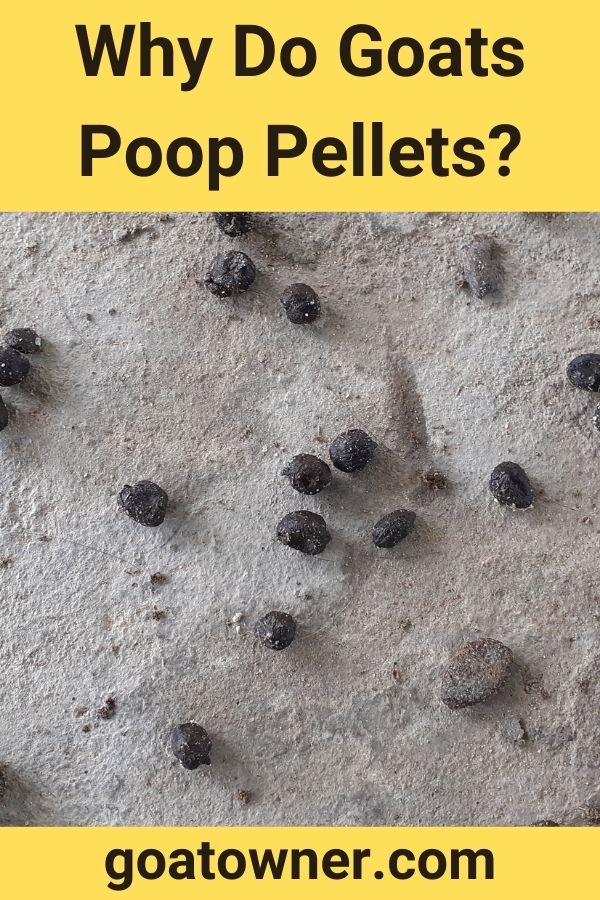I sent my son out to clean the goat’s stable on his own for the first time the other day.
He’s always been enthusiastic about helping out with the goats, and he’s getting to that stage in life where he doesn’t want help doing anything.
He wants to be independent, and I understand the impulse!
So, naturally, that’s extended to wanting to take care of the goats by himself.
When he came in, though, he said they had done a lot of poop—and wondered why it was pellet-shaped.
I decided I would look into it.
So, why do goats poop pellets?
Because goats eat straw, hay and grass, as well as plant matter broadly, they need to break it down quite a lot to be able to eat it. It is also due to the way goats swallow food, regurgitate it, then chew their cud—their partially digested food. This results in broken down food in pellets.
Animals with purely herbivorous diets tend to have poop that looks like pellets—at least, most of the smaller ones do.
Rabbits, goats, and similar animals digest their food in such a way that it is broken up into smaller bits making it easier to pass.
Let’s look further into this.
Do goats always poop in pellets?
Yes, pretty much—sometimes they may not, but this most likely indicates there is something wrong with them on some level.
Diarrhea, for instance, will cause the goat’s poop to be liquid and not at all consistent.
In this case, they will not poop pellets.
As long as their diet is consistent, though, and they are eating the appropriate amounts of the right foods, they really should always be pooping in pellets.
If they seem to be passing large stools, or something more liquid, then they are likely having a digestive issue of some kind that you should get them checked for.
So, why is this the case, then?
Let’s consider it.
Why do goats poop in pellet shapes?
So, the basic reason is to do with the sheer amount of food they need to eat.
For their size, goats have to spend a good deal of their day eating, and need a relatively large amount of food.
All of that will be plant matter and, in most cases, mostly hay.
In order for a goat to be able to get all the nutrients from hay, they need to be able to break it down to a considerable degree.
The first way they do this is by continuously chewing their cud.
This means that they swallow their food after chewing it, then later on regurgitate it again to be chewed a second time.
With food that has been this broken down and chewed up, it is bound to end up in a very small form.
Another reason is that, due to the amount they eat, it would be difficult to continuously pass such food any other way.
They pass it at a steady rate in small amounts, otherwise it would end up causing pain to their rear end.
So, the simple answer is that it’s to do with their diet. with a diet of exclusively plant matter, they have to eat a lot, and thus they also have to pass a lot!
What animals poop round pellets?
But goats are not the only ones that do this.
We have many other examples across the animal kingdom.
The main ones that may come to mind are rabbits and hares.
Whether you’ve had rabbits as pets or spent any time on a field where rabbits have been, you’ve probably seen their pellet-shaped poops.
Hares, of course, also poop in pellet form.
Interestingly, neither of these animals chew their cud in the way goats do.
So, the reason they poop in pellets is again more about smoothly moving everything through their digestive system.
Sheep also poop in round pellets, though.
Sheep are similar to goats but they are not the same, but crucially they do chew their cud in the same way.
This leads to the same thoroughly broken down food which is passed as pellets.
Many other ruminants, like deer also poop in pellets.
Other animals that poop pellets include rats, mice, foxes, cayotes and even some kinds of snake.
Do goats fart?
All of that chewing and all of the breaking down of tough foods leads on the one hand to pellet shaped poops, but there’s one other inevitable outcome: gas.
Goats produce a lot of gas and do indeed fart, although they tend to burp a lot more than they fart.
Food breaking down in the room produces a lot of food, and since they are eating more or less constantly, they also tend to spend most of the day burping and farting.
Generally, though, these farts do not smell too bad—most bad smelling farts come from meat eating animals!
No type of poop is really all that nice to deal with and clean, but the fact is that goats make it easier for us than a lot of other animals do.
Goat poop, due to it just being grass and other plant matter, does not smell too bad and comes in small, easy to move packages.
It is in pellets because passing lots of small pellets is easier for moving through the sheer amount of plant matter that a goat must in order to keep up its diet.

